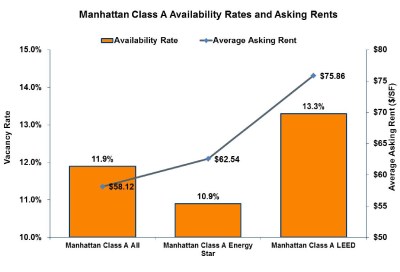Conventional wisdom would have it that green buildings command a rent premium and might also have a lower availability rate.
In Manhattan that’s at least partially true.

Cassidy Turley compared all Manhattan Class A buildings with those that are part of the Energy Star program as well as those that have some sort of LEED certification. Regarding total availability rates, the entire Class A Manhattan inventory (293 buildings) comes in at 11.9 percent.
The 74 Energy Star buildings perform a bit better, coming in at 10.9 percent. Most fascinating, though, is that the 30 LEED-certified buildings come in at a higher, 13.3 percent availability rate. There is a bit of a caveat with that last figure, however, as most of that availability is contained in just four buildings—11 Times Square (newly constructed with 620,000 square feet vacant), 1221 Avenue of the Americas (537,000 square feet available from vacating tenant Societe Generale), 1271 Avenue of the Americas (417,000 square feet of sublease space available) and 350 Fifth Avenue (a 279,000-square-foot block of direct availability). Each of those properties has a unique reason or two why it has such a steep availability rate—it’s doubtful that any of it has to do with LEED certification. Even more telling than the availability rate, however, is the average asking rent.
For the 293 Class A Manhattan buildings, the average asking rent for its available space is $58.12 per square foot; the Energy Star buildings come in 7.6 percent above that figure for an average of $62.54 per square foot; and, finally, those 30 LEED-certified buildings command $75.86 per square foot for a whopping 30.5 percent premium over the total Class A Manhattan inventory.
Granted, these numbers are for just a single period of time. It’s hard to point to a trend as there remain relatively few LEED-certified buildings—just 8.9 percent of the total Manhattan inventory—and the process is still, generally speaking, in its infancy. But just looking at this snapshot, one would assume that the future looks quite bright (solar or energy-efficient bulbs only please).
Robert Sammons, Cassidy Turley



